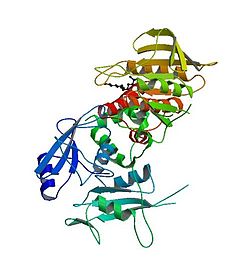Tyrosine-protein phosphatase non-receptor type 11 (PTPN11) also known as protein-tyrosine phosphatase 1D (PTP-1D), Src homology region 2 domain-containing phosphatase-2 (SHP-2), or protein-tyrosine phosphatase 2C (PTP-2C) is an enzyme that in humans is encoded by the PTPN11 gene. PTPN11 is a protein tyrosine phosphatase (PTP) Shp2.[5][6]
PTPN11 is a member of the protein tyrosine phosphatase (PTP) family. PTPs are known to be signaling molecules that regulate a variety of cellular processes including cell growth, differentiation, mitotic cycle, and oncogenic transformation. This PTP contains two tandem Src homology-2 domains, which function as phospho-tyrosine binding domains and mediate the interaction of this PTP with its substrates. This PTP is widely expressed in most tissues and plays a regulatory role in various cell signaling events that are important for a diversity of cell functions, such as mitogenic activation, metabolic control, transcription regulation, and cell migration. Mutations in this gene are a cause of Noonan syndrome as well as acute myeloid leukemia.[7]
- ^ a b c GRCh38: Ensembl release 89: ENSG00000179295 – Ensembl, May 2017
- ^ a b c GRCm38: Ensembl release 89: ENSMUSG00000043733 – Ensembl, May 2017
- ^ "Human PubMed Reference:". National Center for Biotechnology Information, U.S. National Library of Medicine.
- ^ "Mouse PubMed Reference:". National Center for Biotechnology Information, U.S. National Library of Medicine.
- ^ Jamieson CR, van der Burgt I, Brady AF, van Reen M, Elsawi MM, Hol F, Jeffery S, Patton MA, Mariman E (December 1994). "Mapping a gene for Noonan syndrome to the long arm of chromosome 12". Nat. Genet. 8 (4): 357–60. doi:10.1038/ng1294-357. PMID 7894486. S2CID 1582162.
- ^ Freeman RM, Plutzky J, Neel BG (December 1992). "Identification of a human Src homology 2-containing protein-tyrosine-phosphatase: a putative homolog of Drosophila corkscrew". Proc. Natl. Acad. Sci. U.S.A. 89 (23): 11239–43. Bibcode:1992PNAS...8911239F. doi:10.1073/pnas.89.23.11239. PMC 50525. PMID 1280823.
- ^ "Entrez Gene: PTPN11 protein tyrosine phosphatase, non-receptor type 11 (Noonan syndrome 1)".





